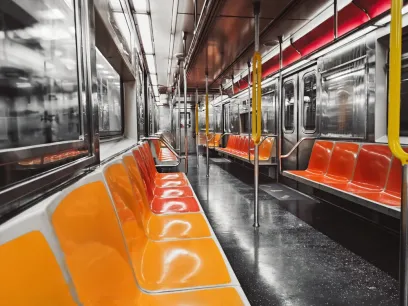Staying Safe on the Go: Slip and Fall Accidents in Public Transportation

Injured?
Slip and fall accidents can happen anywhere but are especially common in public transportation hubs and vehicles. If not managed and maintained properly, these high-traffic areas can be high risk for unsuspecting passengers.
Common Causes of Slip and Fall Accidents in Public Transportation
Public transportation, including buses, transit hubs, and trains, poses unique slip and fall risks due to its design and usage patterns. Some of the most frequent causes include:
Wet Floors
Wet surfaces are a leading cause of public transportation accidents, from spilled drinks to weather-related puddles.
Sudden Stops
The sudden jolt when a bus or train brakes can cause passengers to lose their balance, especially when standing.
Poorly Maintained Vehicles
The risk of falling increases when issues with vehicle maintenance and waiting areas exist, such as loose handrails, worn or damaged flooring, and broken steps on buses or trains.
Icy or Wet Platforms
During bad weather, outdoor walkways and platforms can become slippery with ice or rain, making them hazardous for passengers.
Uneven Surfaces
Raised tiles, cracked pavement, and other uneven surfaces in stations or terminals can cause trips and falls.
Crowded Conditions
Busy platforms and transit vehicles can make it hard to move safely, increasing the likelihood of tripping or losing balance.
Who Is Liable in Public Transportation Slip and Fall Accidents?
Determining liability in slip and fall accidents on public transportation can be complex, as several parties may be responsible:
Government Agencies
If there is an accident on public transport, and the systems are government-operated (such as city transit authorities), the agency in charge may be liable for negligence in maintaining safe conditions. Government-operated transportation can involve legal challenges due to governmental immunity laws, which differ from those of private entities.
Private Contractors
In cases where maintenance or cleaning is outsourced, the contractor could be liable if their actions contributed to unsafe conditions.
Transit Operators
Individual operators might share responsibility if their driving actions, such as sudden braking, caused the accident. Liability often hinges on the ownership and operation of the transit system.
If you have a public transportation accident claim, a slip and fall lawyer can help you understand liability and your rights.
What to Do After a Slip and Fall Accident on Public Transportation
If you experience a slip and fall on public transportation, taking the following steps can help protect your rights and strengthen your potential claim:
Report the Incident
Immediately following an incident, inform the driver, station manager, or transit authority about the accident. Be sure to request a copy of the incident report, as this will serve as documentation that can help to strengthen your case.
Seek Medical Attention
Prioritize your health by seeking prompt medical care, even if your injuries seem minor initially. Some injury symptoms may not be immediately apparent, and documentation of injuries is essential to your claim.
Gather Evidence
Photograph the accident scene, capturing hazardous conditions like wet floors, broken steps, or icy surfaces.
Collect Witness Information
If there were any witnesses to your fall, collecting their information may help substantiate your claim.
Retain Proof of Use
Keep any tickets, passes, or receipts that prove that you were on public transportation during the incident.
Contact Morgan & Morgan
A slip and fall accident lawyer at Morgan & Morgan can help you gather evidence, understand your rights, and navigate the legal process to pursue the compensation you deserve for your injuries and losses.
Challenges in Filing a Slip and Fall Claim Against Public Transportation Authorities
Slip and fall claims against public transportation authorities can present unique challenges, particularly when the defendant is a government agency. Some common hurdles include:
- Shorter Statute of Limitations: Lawsuits against government entities often have much shorter filing deadlines than claims against private companies.
- Damage Caps: Many jurisdictions limit the compensation one can recover in lawsuits against public entities.
- Notice of Claim Requirement: In many areas, you must file a formal notice of claim before suing a government entity detailing the incident and proposed damages.
Working with a Morgan & Morgan slip and fall lawyer experienced in public entity claims can be beneficial in navigating these complexities. Understanding the ownership of the transit system involved in your accident will help determine who may be held liable and what legal requirements or limitations apply to your claim.
Proving Negligence in a Public Transportation Slip and Fall Case
You must prove negligence in a slip and fall claim against a public transportation entity. Key elements include:
Failure to Maintain Safe Conditions
Showing that the entity did not take reasonable steps to keep the premises safe, such as failure to complete regular maintenance, may help substantiate your claim.
Inadequate Signage
If the hazard that contributed to your slip and fall accident was not properly marked with warning signs, such as wet floor signs, they may be liable.
Delayed Response to Hazards
Proving that the entity was aware (or should have been aware) of the hazard but failed to remedy it promptly may further your negligence claim.
Documentation is crucial to establishing negligence. Any proof that the operator or agency knew about the hazard and did not act can support your claim.
Morgan & Morgan Can Help
Slip and fall accidents in public transportation settings can result in significant injuries and complex legal battles. If you’re injured in a slip and fall accident on public transit, Morgan & Morgan can advise you on the cause of the accident, establish liability, and carefully document your case to help you pursue compensation. With over 35 years of experience, our army of over 1,000 trial-ready lawyers can see your personal injury claim all the way to court if necessary.
Hiring one of our lawyers is easy, and you can get started in minutes with a free case evaluation.
Injured on Public Transit? Frequently Asked Questions Answered
Who can I sue if I slip and fall on public transportation property?
If you have suffered a slip and fall accident on public transportation property, you may be able to sue various parties, depending on who is responsible for maintaining the area where the accident occurred. Potential defendants include government agencies (for public transportation systems), private companies (for outsourced maintenance or operations), and individual transit operators if their actions contributed to the accident. Identifying the responsible party is essential as government entities often have different legal procedures than private companies.
What is the statute of limitations for filing a claim against a public transportation authority?
The statute of limitations for filing a claim against a public transportation authority varies by state and jurisdiction. While claims against public entities typically have shorter deadlines than those against private individuals or companies, you may need to first file an initial notice of claim, after which you may have additional time to pursue the lawsuit formally. An experienced slip and fall attorney at Morgan & Morgan can help you understand the specific deadlines for your case.
How do I prove negligence in a slip and fall case involving public transportation?
To prove negligence in a slip and fall case involving public transportation, you must show that the responsible party failed to maintain safe conditions, failed to provide adequate warnings of a hazard, or delayed responding to hazardous conditions. Evidence might include photos of dangerous conditions or hazards, maintenance records showing neglect, or witness testimonies. Establishing that the transit authority knew or should have known about the danger and did not address it promptly can strengthen your claim.
Can I file a claim if I slipped on a bus or train due to sudden movement?
Yes, you may be able to file a claim if you slipped due to sudden movement on a bus or train, especially if the driver’s actions were abrupt or excessive and contributed to unsafe conditions. However, proving liability may require showing that the sudden movement was unnecessary or reckless. Consulting with an attorney can help determine whether the circumstances support a claim.
What should I do if I slip and fall at a train or bus station?
If you suffer from a slip and fall accident at a train or bus station, take the following steps:
- Report the incident to station personnel and request an incident report.
- Seek medical attention even if injuries seem minor.
- Take photos of the accident scene, being sure to capture any hazards.
- Gather witness contact information to help substantiate your claim.
- Keep any documentation showing you were at the station, such as ticket stubs, receipts, or passes.
- Contact a lawyer to help you navigate the legal process and protect your rights.
Who is responsible for accidents on platforms or stations that are publicly owned?
The government agency responsible for the station’s maintenance is typically liable for accidents on publicly owned platforms or stations. However, if a private contractor was hired to maintain or clean the area, liability could extend to the contractor if they failed to keep the space safe. Determining responsibility depends on the specific circumstances and contracts governing the property’s upkeep.
Can I recover compensation if my accident happened during a rush-hour commute on public transportation?
Yes, you may be eligible to recover compensation if you slip and fall during rush hour on public transportation. Although high traffic can contribute to accidents, transportation authorities must maintain safe conditions regardless of crowd levels. If negligence on the part of the transit authority or operator contributed to the accident, you may have grounds to pursue compensation.
What types of evidence do I need to prove negligence in a slip and fall case at a transportation hub?
The following evidence may help you solidify a case to prove negligence in a slip and fall case at a transportation hub. Include photos of the hazard, such as wet floors or damaged steps, witness statements, surveillance footage, maintenance logs showing neglect, and records of previous complaints about similar hazards. Any evidence demonstrating that the transportation authority knew or should have known about the hazard can significantly strengthen your case.
Who is responsible for maintaining safety at public transportation hubs?
The entity that owns or operates the facility, often a government agency, is typically responsible for the safety of public transportation hubs. However, if a private contractor has been hired for cleaning or maintenance, they may share the responsibility if their actions (or inactions) create an unsafe condition. Liability depends on the agreements in place for the hub's upkeep and the specifics of the incident.
Can I sue a public transportation authority for a slip and fall accident?
You can sue a public transportation authority for a slip and fall accident if you prove negligence. However, filing a claim against a public entity involves unique legal requirements, such as strict notice deadlines and potential damage caps. Consulting an attorney experienced in public entity claims can help you navigate the legal process and improve your chances of a successful outcome.

We've got your back
Injured?
Not sure what to do next?
We'll guide you through everything you need to know.

